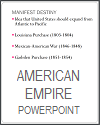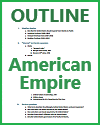Our free outlines and PowerPoint presentations can be effective tools for helping American History students properly comprehend the events of the era of American imperialism at the turn of the 20th century. Here is how these free educational resources can aid in teaching and learning about this period of population, financial, and industrial growth in United States history.
Outlines on American Growth and Imperialism:
- Structural Framework: Outlines provide a structured framework that organizes key information chronologically or thematically. This helps students see the sequence of events and their interconnections during the era of American imperialism.
- Clarity and Focus: An outline breaks down complex topics into manageable sections, ensuring that students focus on key concepts, individuals, and events without feeling completely overwhelmed by details. While details are important and capture students' attention, such as the brutality of the police violence at the Haymarket Riot, it is crucial that students keep the bigger picture in mind (in this case, the robber barons' quest for riches at the expense of the working class, and the states' complicity in enabling this desire).
- Visual Organization: Visual learners can benefit from the visual organization of an outline, making it easier to comprehend and retain information.
- Study Aid: Students can use outlines as study aids, condensing larger topics into concise notes for review before exams or assessments.
- Reference Tool: Outlines serve as reference materials for students to revisit when writing essays, preparing presentations, or engaging in discussions about American imperialism.
PowerPoint Presentations on American Growth and Imperialism:
- Visual Engagement: PowerPoint presentations incorporate visuals, such as maps, images, political cartoons, and graphs, which can engage students and provide a visual context for the events of American imperialism. Seeing is believing!
- Sequential Storytelling: PowerPoint slides allow for a sequential presentation of information, helping students follow the narrative of American imperialism and its key milestones.
- Multimodal Learning: By incorporating text, images, and sometimes audio or video clips, PowerPoint presentations cater to different learning styles and enhance understanding through multiple senses.
- Interactive Elements: Hyperlinks, clickable maps, and animations in PowerPoint presentations can make the learning experience more interactive and engaging for students.
- Organization and Focus: Presenters can use PowerPoint to maintain a structured and focused discussion of American imperialism, ensuring that important topics are covered systematically.
- Discussion Prompts: PowerPoint slides can include discussion questions or prompts to encourage class participation and critical thinking.
Combining Outlines and PowerPoint:
- Start with an outline to introduce the overarching themes, events, and key concepts of American imperialism at the turn of the Century.
- Use PowerPoint slides to visually illustrate and delve deeper into specific aspects of American imperialism, such as the Spanish-American War, the acquisition of territories, the role of political figures, and the impact on foreign policy.
- Encourage students to take notes during the PowerPoint presentation using the outline as a reference, allowing them to capture key points and details.
- Conclude with a review that revisits the outline, summarizing the main takeaways and encouraging class discussions or activities related to American imperialism.
By combining our free printable outlines and PowerPoint presentations on American economic and territorial expansion and growth at the turn of the last Century, educators can provide a comprehensive and engaging learning experience that caters to diverse learning styles and helps students grasp the complexities of American imperialism during this pivotal era in American history.
|











